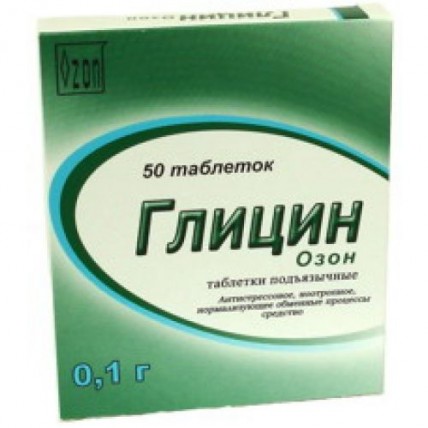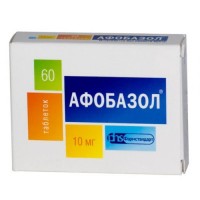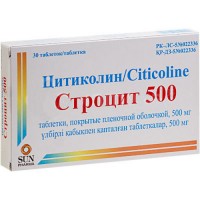Ozone Glycine 100 mg (50 tablets) ling.
- $3.00
Out Of Stock
The instruction
for medical use
of OZONE GLYCINE medicine
the Trade name
Glycine Ozone
the International unlicensed
name Glycine Dosage Form
of the Tablet hypoglossal, 100 mg
Structure
One tablet contains
active agent glycine - 100 mg,
excipients: povidone (kollidon 25), magnesium stearate, cellulose microcrystalline
the Description
of the Tablet of white color with risky on the one hand and a facet from two parties. Presence of marbling is allowed.
Pharmacotherapeutic group
Other psychostimulants and nootropa
the Code of automatic telephone exchange N06BX
the Pharmacological
Pharmacokinetics Belongs properties to replaceable amino acids. Glycine easily gets into the majority of biological liquids and body tissues, including a brain, is metabolized, its accumulation in fabrics does not happen. Quickly collapses in a liver glitsinoksidazy to water and carbon dioxide.
The pharmacodynamics
Glitsin is the central neurotransmitter regulating a metabolism normalizes and activates processes of protective braking in the central nervous system. Improves metabolic processes in brain tissues, has antidepressive and sedative effect. Glycine - and GAMK-ergichesky, alfa1 - adrenoceptor blocking, antioxidant, anti-toxic action possesses, regulates activity of glutamate (NMDA) receptors at the expense of what reduces psychoemotional pressure, aggression and conflictness, increases social adaptation, improves mood, facilitates backfilling and normalizes a dream, increases intellectual working capacity, reduces expressiveness of vegetovascular disturbances.
L-glycine (glycine) - takes part in synthesis of the substances, major for an organism: nucleic acids, glutathione, bile acids, etc. Glycine is used in porphyrine predecessor synthesis gem in a hemoglobin molecule and also purine bases - the most important elements of nucleic acids. Glycine is included into structure of glutathione - the sulfur-containing substance playing a special role in the system of anti-radial protection.
Glycine participates in desintoxication reactions, being included hippuric acid and also in synthesis of bile acids (glycocholic acid). Besides, glycine is important in processes of biosynthesis of oxalic acid.
Indications
- reduced intellectual working capacity
- stressful states – psychoemotional pressure (during examinations, situations conflict, etc.)
- deviant forms of behavior of children and teenagers
- various functional and organic diseases of nervous system which are followed by hyperexcitability, emotional instability, a sleep disorder: neurosises, neurosis-like states and vegeto-vascular dystonia, consequences of neuroinfections and a craniocereberal injury, perinatal and other forms of encephalopathies (including alcoholic genesis)
- an ischemic stroke
In narcology during remission at the encephalopathy phenomena, organic lesions of the central and peripheral nervous system
the Route of administration and doses
Glycine is podjyazychno applied to increase in intellectual working capacity, reduction of psychoemotional pressure or transbukalno on 100 mg (in tablets or, including, to children up to 6 years in the form of powder after crushing of a tablet). To children, teenagers and adults at a psychoemotional tension, decrease in memory, attention, intellectual working capacity, a delay of intellectual development, at deviant forms of behavior glycine is appointed on 1 tablet 2-3 times a day within 14-30 days.
In functional and organic lesions of nervous system - to children up to three years appoint 0.5 tablets (50 mg) in the form of powder after crushing of a tablet to reception 2-3 times a day within 7-14 days, further on 50 mg 7-10 days once a day. A daily dose - 100-150 mg, course — 2000-2600 mg. To children 3 years up to 6 years in the form of powder after crushing of a tablet are more senior and the adult appoint on 1 tablet or in the form of powder after crushing of a tablet 2-3 times a day, a course of treatment of 7-14 days. The course of treatment can be increased up to 30 days, if necessary the course is repeated in 30 days.
In sleep disorders - glycine is appointed in 20 minutes prior to a dream or just before a dream on 0.5-1 tablet (depending on age).
In an ischemic brain stroke: within the first 3-6 hours from development of a stroke appoint 1000 mg transbukalno or podjyazychno with one teaspoon of water, further within 1-5 days on 1000 mg a day, then within the next 30 days 1-2 tablets 3 times a day.
In narcology - on 1 tablet 2-3 times a day within 14-30 days. If necessary courses repeat 4-6 times a year.
Side effects
Are possible allergic reactions
of the Contraindication
Individual hypersensitivity to drug components
Medicinal interactions
Weakens expressiveness of effects of antipsychotic means (neuroleptics), anxiolytics, anti-Depressanums, hypnotic drugs and anticonvulsants.
The special
instructions Pregnancy and the period a lactation
drug use on doctor's orders is possible.
Features of influence of medicine on ability to run the vehicle or potentially dangerous mechanisms
the Overdose does not influence
the form of release and packing
On 50 tablets in blister strip packaging from a film of polyvinylchloride and aluminum foil is not revealed.
1 blister strip packaging together with the instruction for use in the state and Russian languages is placed in a pack from cardboard.
To Store storage conditions in the dry, protected from light place, at a temperature not higher than 25 wasps.
To store out of children's reach!
3 years
not to use a period of storage after the term specified on packing.
Prescription status
Without prescription
LLC Ozon Producer.
Address: Russia, Zhigulyovsk, Pesochnaya St., 11,
ph.: (84862) 3-07-05, 3-07-09.
The address of the organization accepting claims for territories of the Republic of Kazakhstan from consumers on quality of products
of Rapharm LLP, Almaty, Zheltoksan St. 101, apartment 3
Ph. 279-43-18
Email: zelga@inbox.ru
for medical use
of OZONE GLYCINE medicine
the Trade name
Glycine Ozone
the International unlicensed
name Glycine Dosage Form
of the Tablet hypoglossal, 100 mg
Structure
One tablet contains
active agent glycine - 100 mg,
excipients: povidone (kollidon 25), magnesium stearate, cellulose microcrystalline
the Description
of the Tablet of white color with risky on the one hand and a facet from two parties. Presence of marbling is allowed.
Pharmacotherapeutic group
Other psychostimulants and nootropa
the Code of automatic telephone exchange N06BX
the Pharmacological
Pharmacokinetics Belongs properties to replaceable amino acids. Glycine easily gets into the majority of biological liquids and body tissues, including a brain, is metabolized, its accumulation in fabrics does not happen. Quickly collapses in a liver glitsinoksidazy to water and carbon dioxide.
The pharmacodynamics
Glitsin is the central neurotransmitter regulating a metabolism normalizes and activates processes of protective braking in the central nervous system. Improves metabolic processes in brain tissues, has antidepressive and sedative effect. Glycine - and GAMK-ergichesky, alfa1 - adrenoceptor blocking, antioxidant, anti-toxic action possesses, regulates activity of glutamate (NMDA) receptors at the expense of what reduces psychoemotional pressure, aggression and conflictness, increases social adaptation, improves mood, facilitates backfilling and normalizes a dream, increases intellectual working capacity, reduces expressiveness of vegetovascular disturbances.
L-glycine (glycine) - takes part in synthesis of the substances, major for an organism: nucleic acids, glutathione, bile acids, etc. Glycine is used in porphyrine predecessor synthesis gem in a hemoglobin molecule and also purine bases - the most important elements of nucleic acids. Glycine is included into structure of glutathione - the sulfur-containing substance playing a special role in the system of anti-radial protection.
Glycine participates in desintoxication reactions, being included hippuric acid and also in synthesis of bile acids (glycocholic acid). Besides, glycine is important in processes of biosynthesis of oxalic acid.
Indications
- reduced intellectual working capacity
- stressful states – psychoemotional pressure (during examinations, situations conflict, etc.)
- deviant forms of behavior of children and teenagers
- various functional and organic diseases of nervous system which are followed by hyperexcitability, emotional instability, a sleep disorder: neurosises, neurosis-like states and vegeto-vascular dystonia, consequences of neuroinfections and a craniocereberal injury, perinatal and other forms of encephalopathies (including alcoholic genesis)
- an ischemic stroke
In narcology during remission at the encephalopathy phenomena, organic lesions of the central and peripheral nervous system
the Route of administration and doses
Glycine is podjyazychno applied to increase in intellectual working capacity, reduction of psychoemotional pressure or transbukalno on 100 mg (in tablets or, including, to children up to 6 years in the form of powder after crushing of a tablet). To children, teenagers and adults at a psychoemotional tension, decrease in memory, attention, intellectual working capacity, a delay of intellectual development, at deviant forms of behavior glycine is appointed on 1 tablet 2-3 times a day within 14-30 days.
In functional and organic lesions of nervous system - to children up to three years appoint 0.5 tablets (50 mg) in the form of powder after crushing of a tablet to reception 2-3 times a day within 7-14 days, further on 50 mg 7-10 days once a day. A daily dose - 100-150 mg, course — 2000-2600 mg. To children 3 years up to 6 years in the form of powder after crushing of a tablet are more senior and the adult appoint on 1 tablet or in the form of powder after crushing of a tablet 2-3 times a day, a course of treatment of 7-14 days. The course of treatment can be increased up to 30 days, if necessary the course is repeated in 30 days.
In sleep disorders - glycine is appointed in 20 minutes prior to a dream or just before a dream on 0.5-1 tablet (depending on age).
In an ischemic brain stroke: within the first 3-6 hours from development of a stroke appoint 1000 mg transbukalno or podjyazychno with one teaspoon of water, further within 1-5 days on 1000 mg a day, then within the next 30 days 1-2 tablets 3 times a day.
In narcology - on 1 tablet 2-3 times a day within 14-30 days. If necessary courses repeat 4-6 times a year.
Side effects
Are possible allergic reactions
of the Contraindication
Individual hypersensitivity to drug components
Medicinal interactions
Weakens expressiveness of effects of antipsychotic means (neuroleptics), anxiolytics, anti-Depressanums, hypnotic drugs and anticonvulsants.
The special
instructions Pregnancy and the period a lactation
drug use on doctor's orders is possible.
Features of influence of medicine on ability to run the vehicle or potentially dangerous mechanisms
the Overdose does not influence
the form of release and packing
On 50 tablets in blister strip packaging from a film of polyvinylchloride and aluminum foil is not revealed.
1 blister strip packaging together with the instruction for use in the state and Russian languages is placed in a pack from cardboard.
To Store storage conditions in the dry, protected from light place, at a temperature not higher than 25 wasps.
To store out of children's reach!
3 years
not to use a period of storage after the term specified on packing.
Prescription status
Without prescription
LLC Ozon Producer.
Address: Russia, Zhigulyovsk, Pesochnaya St., 11,
ph.: (84862) 3-07-05, 3-07-09.
The address of the organization accepting claims for territories of the Republic of Kazakhstan from consumers on quality of products
of Rapharm LLP, Almaty, Zheltoksan St. 101, apartment 3
Ph. 279-43-18
Email: zelga@inbox.ru










